Lower Dolpo Trek
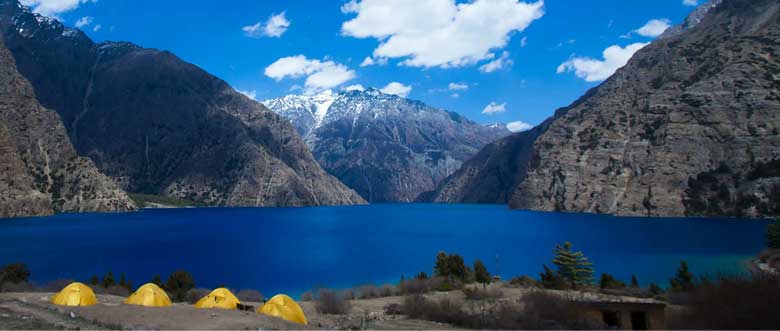
Trip Overview
Iteneary Details
Includes & Excludes
FAQ
Map
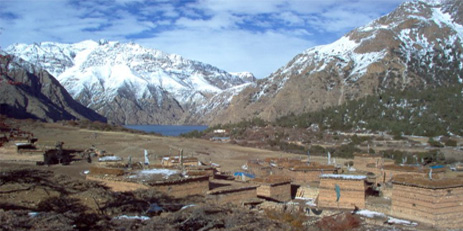 Make a rendezvous with the remote Himalaya mountains of Dolpo, the land of the Oscar nominated Caravan fame, Thinley, a culture nearby Tibet that has survived its originality for centuries. Thanks to the reportage of National Geographic Fame Eric Valli, the Dolpo region of Nepal has been shown in all its integrity and full mystical experience. Along with one of the deepest Himalayan Lakes, the Phokhsundo with beautiful turquoise blue water, watch the yak caravans that maintain the traditional salt trade with Tibet. The region lies further north from the Dhaulagiri Range in the rain shadow of the Himalayas - reflected in the colorful barren slopes of the mountains where the play of light and shadow is a perpetual fascinating spectacle. In summer, the caravans of yaks and sheep run through this valley on a trade route through the Himalayas and allows the exchange not only goods but also of ideas between the Tibetan Plateau and the valleys of Nepal.
Make a rendezvous with the remote Himalaya mountains of Dolpo, the land of the Oscar nominated Caravan fame, Thinley, a culture nearby Tibet that has survived its originality for centuries. Thanks to the reportage of National Geographic Fame Eric Valli, the Dolpo region of Nepal has been shown in all its integrity and full mystical experience. Along with one of the deepest Himalayan Lakes, the Phokhsundo with beautiful turquoise blue water, watch the yak caravans that maintain the traditional salt trade with Tibet. The region lies further north from the Dhaulagiri Range in the rain shadow of the Himalayas - reflected in the colorful barren slopes of the mountains where the play of light and shadow is a perpetual fascinating spectacle. In summer, the caravans of yaks and sheep run through this valley on a trade route through the Himalayas and allows the exchange not only goods but also of ideas between the Tibetan Plateau and the valleys of Nepal.
The Lower Dolpo Trek is meant for real adventurers wishing for an off-the-beaten-path experience. This remote region in western Nepal was opened for the foreigners only in 1990. The trek passes through Shey-Phoksundo National Park with spectacular mountain scenery, Buddhist monasteries and yak caravans. Our trek takes us through a wooded area, then load through rugged canyons in the barren plateau near the border with Tibet. After your arrival in Kathmandu, make a historical and cultural tour of Kathmandu valley and monuments while we obtain special permit for the lower Dopla trekking. Then we take our flight to Jhupal via Nepalgunj. Experience the high altitude tundra and rocks and the microclimate of Lower Dolpo and Phoksumdo with the cold air of the glaciers of Kanjiroba.
Read more
 Day 01 : Arrival: KTM, transfer to hotel.
Day 01 : Arrival: KTM, transfer to hotel.
Day 02 : Preparation for trek
Day 03 : Flight to Nepalgunj overnight at hotel Batika
Day 04 : Flight to Juphal & trek to Dunai
Day 05 : Trek to Tarakot
Day 06 : Trek to Laieni
Day 07 : Trek to Thulo odhar
Day 08 : Trek to Do-tarap
Day 09 : Exploring day.camp at Do-tarap
Day 10 : Trek to Numala base camp
Day 11 : Numala pass(5350m) camp at Bagala base camp
Day 12 : Bagala pass (5250m) camp at Kharka
Day 13 : Trek to Fokisndo Lake Day 14 : Rest day
Day 14 : Rest day
Day 15 : Trek to Renchi
Day 16 : Trek to Akhe
Day 17 : Trek to Dunai
Day 18 : Trek to Juphal
Day 19 : Flight : Nepalgunj-KTM same day
Day 20 : Free day in KTM
Day 21 : Shopping day in KTM
Day 22 : Final departure, transfer to airport
Read more
Cost Includes
- Airport / Hotel / Airport pick up & drop by private tourist vehicle.
- Standard twin sharing accommodation in a three star hotel in Kathmandu; Breakfast included. (4 nights)
- Twin sharing standard hotel accommodation in Nepalgunj (1 night).
- Guided city tour in Kathmandu by private tourist vehicle.
- All your standard Meals prepared by our expert camping cook and kitchen team during the trek (Breakfasts, Lunches and Dinners).
- Tented accommodation and equipment during the camping trek. (We will provide two man tents, dinning tents, kitchen gear, dining table, chairs, toilet tents, shower tent.)
- Local Himalayan Trail Blazer licensed English speaking guide.
- The required number of local staff, porters and Yaks or Jhopkey (Strong Animal similar to Yak) to carry your luggage during the trek.
- Food, accommodation, salary, insurance, equipment and medicine for all staff.
- Special Trekking Permit US$ 70 per person per day and all local conservation fees.
- Sleeping bag by Himalayan Trail Blazer (which need to be returned after the trek).
- Flight fare from Kathmandu – Nepalgunj– Juphal – Nepalgunj - Kathmandu including airport departure taxes.
- Surface transfer from and to Kathmandu.
- Sightseeing/Monument entrance fees in Kathmandu (On Day 2).
- Farewell dinner in typical Nepali Restaurant with cultural dance show on second last day (On Day 24th).
- All our government taxes, vat, tourist service charges.
- Official expenses.
Cost Does not Include
- Lunch and dinner whilst in Kathmandu.
- Travel insurance which covers emergency Rescue and Evacuation.
- International airfare and airport departure tax.
- Nepal entry visa; you can obtain a visa easily upon your arrival at Tribhuwan International Airport in Kathmandu. (Tourist Visa with Multiple Entries for 30 days can be obtained by paying US $ 40 or equivalent foreign currency. Similarly, Tourist Visa with Multiple Entries for 90 days can be obtained by paying US $ 100. Please bring 2 copies of passport size photos).
- Alcoholic and cold drinks.
- Personal trekking Equipment (See the trekking equipment page).
- Tips for trekking staff and driver (Tipping is expected).
- Any others expenses which are not mentioned on 'Price Includes' section.
Read more
What type of shape do I need to be in, is this trip for me?
This is strenuous trek in very remote region. You need good stamina for a long day effort while crossing the high passes in this trek. Any person suffering from a pre-existing medical condition or diseases must seek medical advice before considering any trek. Whilst on the trek, it is common to experience some discomfort before being fully acclimatized.
To prepare for a strenuous trek you should begin training at least three to four months before your departure. As a guideline, an hour of aerobic exercise three to four times per week would be considered a minimum requirement. The best preparation is bushwalking involving relatively steep ascents and descents. If you can manage a couple of valley floor to ridgeline ascents per comfortable and able to enjoy the trek to the fullest. They are physically strong, sharp-witted and have an incredibly positive attitude towards a life that we would consider extremely tough. There is something about a trek in the Himalaya that draws you back time and time again. For keen walkers it is a paradise and even avowed non-walkers find that one foot just seems to follow the other, drawn by the appeal of what lies beyond.
Will somebody come to pick me up at the airport upon my arrival?
Yes, our airport representative will be there to greet you at the airport. S/he will be displaying an Himalayan Trail Blazer sign board outside the airport terminal. Upon arrival, you will be transferred to your hotel by our tourist vehicle.
What sort of accommodation can I expect in Kathmandu in trekking?
We use standard rooms at three star hotels in Kathmandu with breakfast included.
We provide basic guesthouse in Nepalgunj at twin sharing basis.
Along the trekking routes we provide the best possible camping service complete with comfortable two person tents with good mattresses. A kitchen, dining, shower, toilet tents, chairs with tables are also provided. Refer to the equipment list for items you will need to bring. We usually camp in or near a village, which allows you to buy sweets and drinks, which we do not carry with us. You will also get a small bucket of hot water each morning in your tent for a quick scrub up.
What sort of food can I expect in trekking?
There are whole lot of good restaurents in Kathmandu where you can find any delight of your choice. During your stay in Kathmandu, please note that this package doesnt include any meals.
During the camping our expert camping cook can prepare normal and special meals upon request. There is a wider variety of food available, including Western-style food, and you may request to eat at any point of the day. The camping price includes an all-you-can-eat food service.
What mode of transportation do you use?
Himalayan Trail Blazer is all about providing you with local insights, lifestyle as well as adventure. Depending on the nature of the travel, the transportation to and from the destination varies from domestic flights to vehicular transportation to even piggyback rides on mules and yaks. We provide you only those options which enhance your local experience while allowing you to travel comfortably and efficiently. We use private tourist vehicles for sightseeing, city tours and pickups. Depending on the group size we use cars, minibus, vans or alternatively 4WD SUVs, more maneuverable in travelling along the narrow and bumpy roads of Nepal. All the vehicles are usually air-conditioned unless we are travelling in cooler areas.
We use Tara air, Nepal air for the flight Kathmandu - Nepalgunj - Juphal - Kathmandu.
What is the best season for this trekking?
Our trekking season extends from mid- September to May. From early September the monsoonal rains decrease. By end of September through to December the weather is usually stable with mild to warm days, cold nights. March, April, May, June, October, November are the best time to do this trek.
What is the weather & temperature like in trekking?
Weather in the mountains is notoriously difficult to predict. At night it is generally colder the days are generally warm. Expect the unexpected! The temperature could be as high as 20 deg C to -20 deg C low.
I m a Vegeterain, is that a Problem ?
No problem at all because our camping cooks will mostly serve the vegetarian meals. We always recommend our clients to eat vegetarian meals to avoid the food poisoning, eating heavy meals and non- vegetarian meals at the high altitude is not really safe for the stomach.
Do your guides have trekking guide certificates from the Hotel Management and Tourism Center? Have they received first aid training for high altitude?
Yes, they have all received a 45-day training from the Hotel Management and Tourism Center in Nepal. The guides have also received high altitude first aid training from KEEP (Kathmandu Environmental Education Project).
Do we book our own international flights to and from Nepal?
Yes, you need to book your own International flights. We are a local agent and it would cost you significantly higher to book through us.
Can I charge my digital camera or other equipments on my trip?
These facilities will be available only in few towns by paying some service charges. Remember to bring TWO and THREE pin travel adapters! Please bring the spare batteries.
Is there any communication while we are on trekking?
There are telephones in some villages along the trekking routes from which you can make international calls. All our guides are equipped with the local mobile phone. You may wish to pass the number of our guide to your family for the callback or you can make a call from the guide’s mobile and pay him directly for the international call too.
Can I use credit cards in the places I visit in trekking?
In the cities, yes - to some extent. Once you are out of the cities, all you need is cash. Please change the currency in local Nepali Rupees before you go to the mountains.
How much additional money do I need per day?
It depends on your spending habits. Generally, in Kathmandu, you can allocate USD 10 to USD 15 for a lunch and a dinner.
During the trekking all the meals, hot drinks are included, however USD 8 to USD 12 per person a day will be enough to buy chocolates, few drinks during the trekking.
Do I need to tip my guide and porters? How much would that be?
This is a difficult thing to gauge. We have seen everything from USD 20 to USD 1000 per person for guides and porters. Tipping is not required, but a small gesture of thanks to your guides and local porters. The level of the tip should reflect the level of satisfaction from and personal involvement with your guide. However, we recommend you to spend minimum 10% of your total trip cost for tipping entire local staffs, the ratio of tipping guide and porter will be given to you at the pre-trip meeting in Kathmandu before starting the trek.
What opportunities will I have for shower along the trek?
Yes, we provide you shower facilities during your trek. We erect a shower tent and provide you with Buckets of hot water.
Is Himalayan Trail Blazer's staff insured?
Our company insures all our trekking staff members, including guides, cooks, Sherpas and porters.
Can I add extra days to my trekking trip?
Holiday should never be about making it to the final point quickly. Along your trek we can add days at your request with additional costs to cover guides, porters, accommodation and food.
Do you use yaks/porters on the trek or do we carry all of our own gear?
We normally use Yaks or Jhopkey( Strong animal similar to yak) and porter to carry your luggage, food and camping equipment. All you need to carry is your small day bag for your personal belongings like camera, water bottle, sun cream etc only.
I would like to extend my holiday, any recommendations?
Yes, there are a plenty of options and choices to extend your holiday before or after your main trip.
Can I obtain the visa for Nepal upon on arrival at the airport?
YES, US$ 25 or equivalent foreign currency is required to obtain Tourist Visa with Multiple Entry for 15 days. Likewise, tourist Visa with Multiple Entry for 30 days can be obtained by paying US $ 40 or equivalent foreign currency. Similarly, Tourist Visa with Multiple Entry for 90 days can be obtained by paying US $ 100. Please bring 2 copies of passport size photos.
What immunizations will I need?
No vaccinations are compulsory in Himalaya, but we do recommend you are covered for diphtheria & TB, hepatitis A, hepatitis B, *malaria, typhoid, polio and tetanus.
We also recommend:
A dental check-up prior to travelling.
That you know your blood group in case of emergency.
If you have any pre-existing medical conditions which might affect you on tour, you make these known to your tour leader and Himalayan Trail Blazer at the time of your booking.
Read more

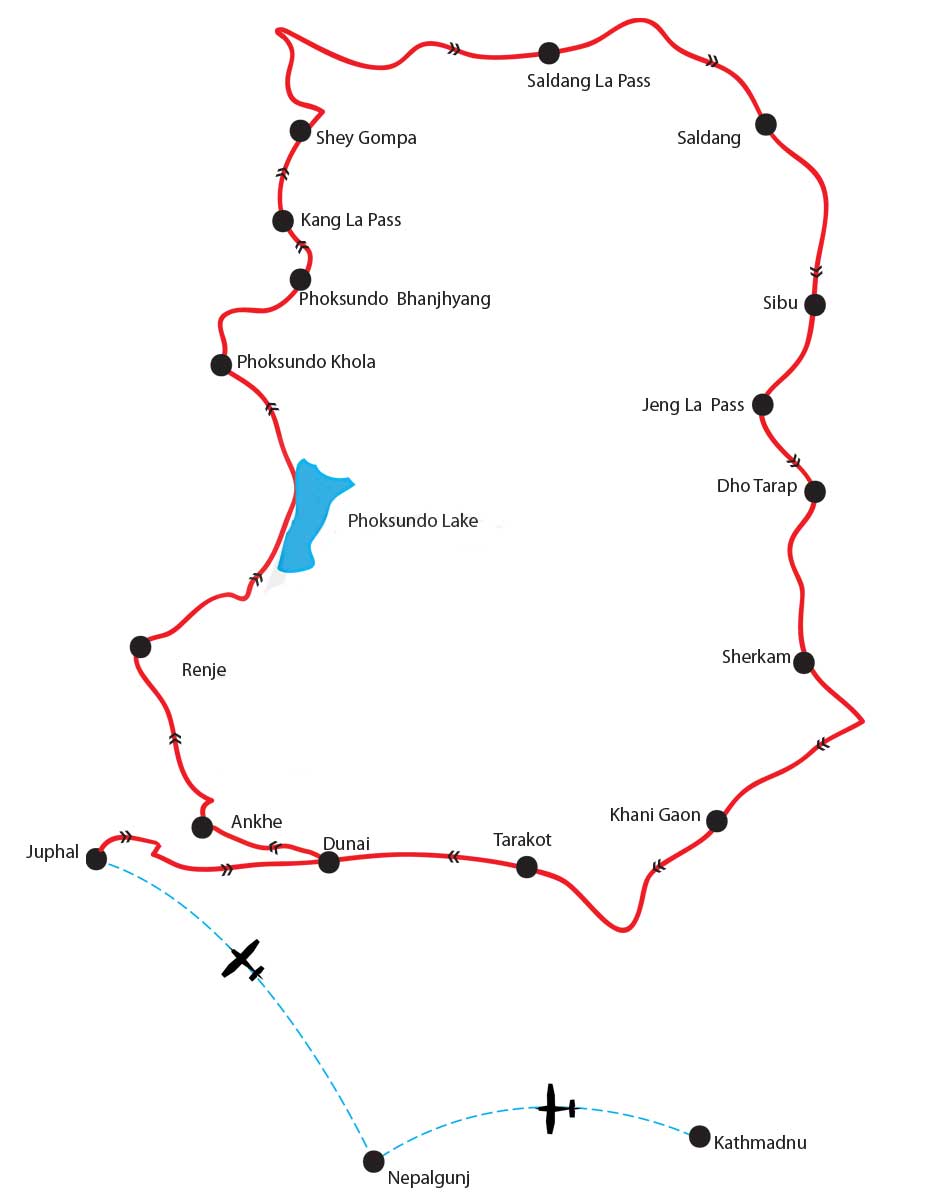

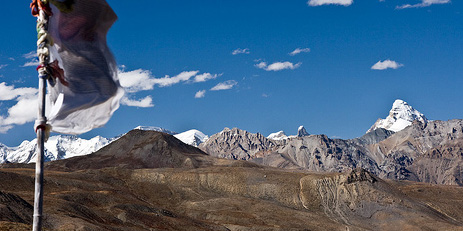 Dolpo, a land beyond the Himalayas, conjures up visions of mysterious monasteries, snow leopards and blue sheep. It is situated in the western part of the country, and is one of the most remote regions in Nepal.
Dolpo, a land beyond the Himalayas, conjures up visions of mysterious monasteries, snow leopards and blue sheep. It is situated in the western part of the country, and is one of the most remote regions in Nepal.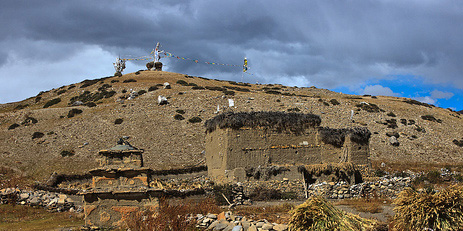 The people that live here number only a few hundred and are among the world's highest dwellers. The villages in Upper Dolpo are 4,300meters and above. It is here specifically that people still practice the pre-Buddhist Bon Po religion. This early sect was almost entirely replaced after Buddhist doctrine began to spread across Tibet in the 9th century.
The people that live here number only a few hundred and are among the world's highest dwellers. The villages in Upper Dolpo are 4,300meters and above. It is here specifically that people still practice the pre-Buddhist Bon Po religion. This early sect was almost entirely replaced after Buddhist doctrine began to spread across Tibet in the 9th century. NOTE: During the trip; weather, local politics, transport or a multitude of other factors, that are beyond our control can result in a change of itinerary. It is, however, very unlikely that the itinerary would be substantially altered; if alterations are necessary the leader will decide what is the best alternative, taking into consideration the best interests of the whole group. Where a change does occur, we do everything we can to minimize its effect, but we cannot be responsible for the results of changes or delays.
NOTE: During the trip; weather, local politics, transport or a multitude of other factors, that are beyond our control can result in a change of itinerary. It is, however, very unlikely that the itinerary would be substantially altered; if alterations are necessary the leader will decide what is the best alternative, taking into consideration the best interests of the whole group. Where a change does occur, we do everything we can to minimize its effect, but we cannot be responsible for the results of changes or delays.